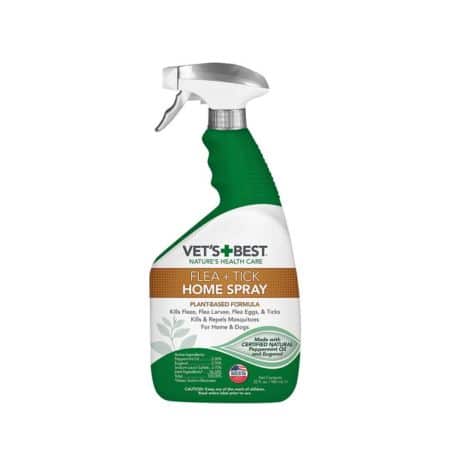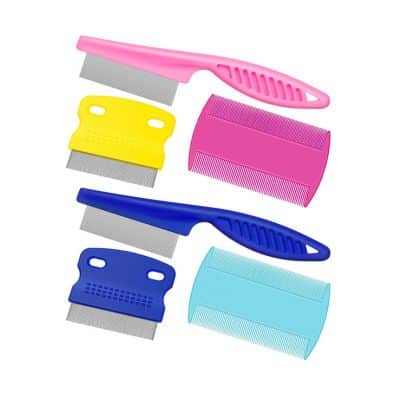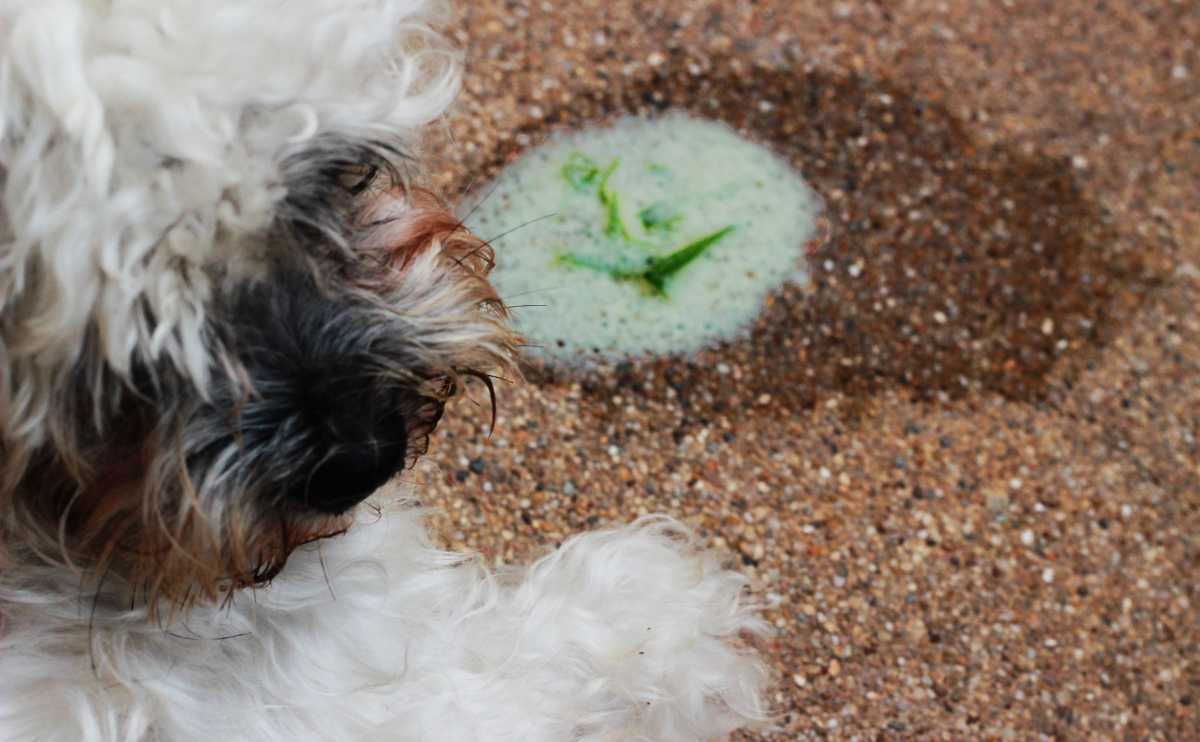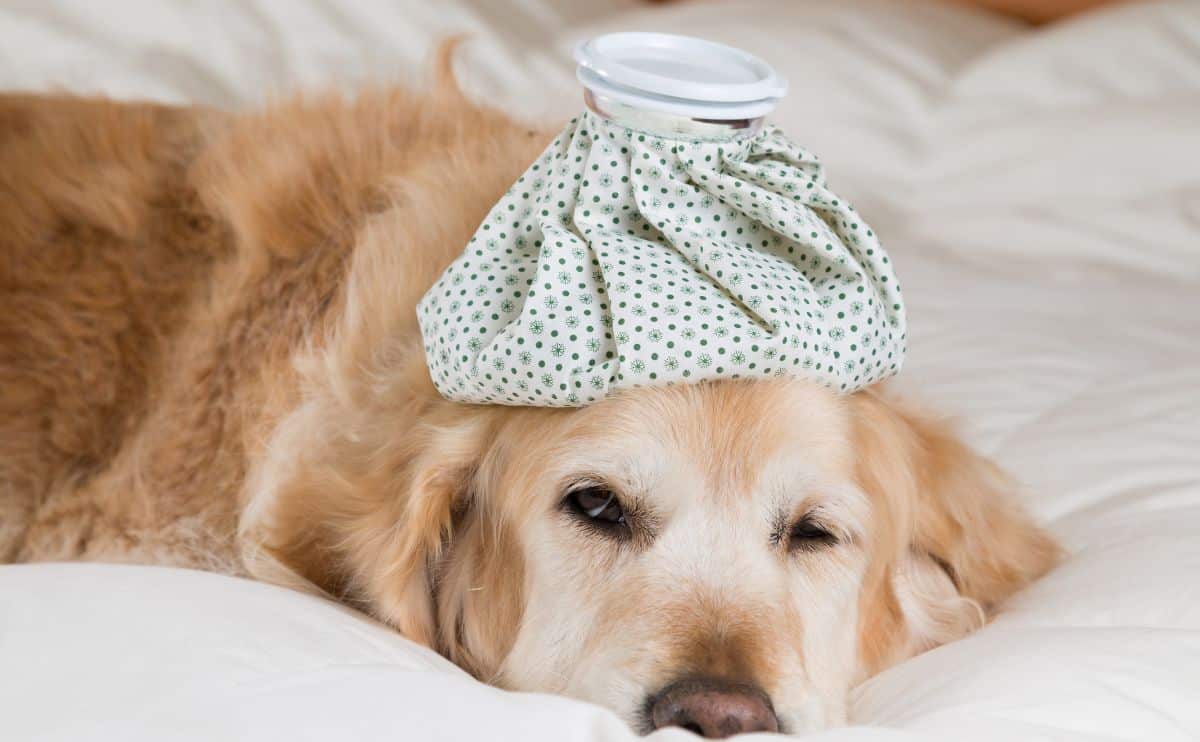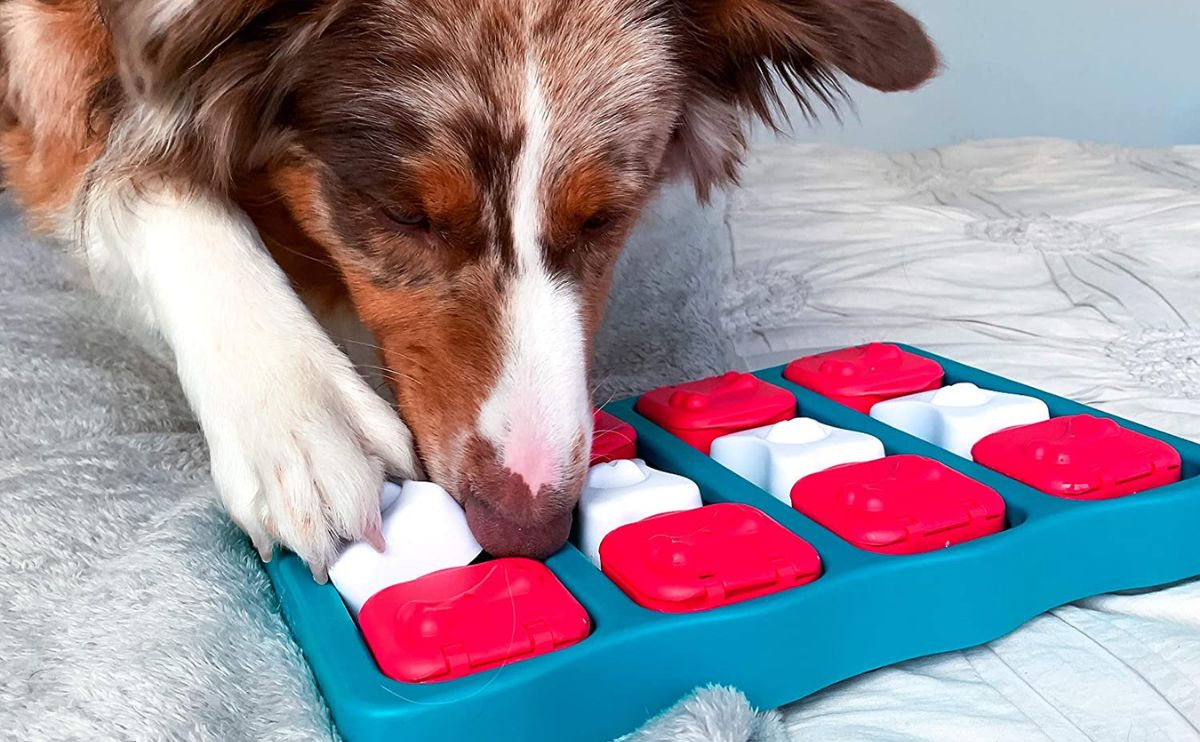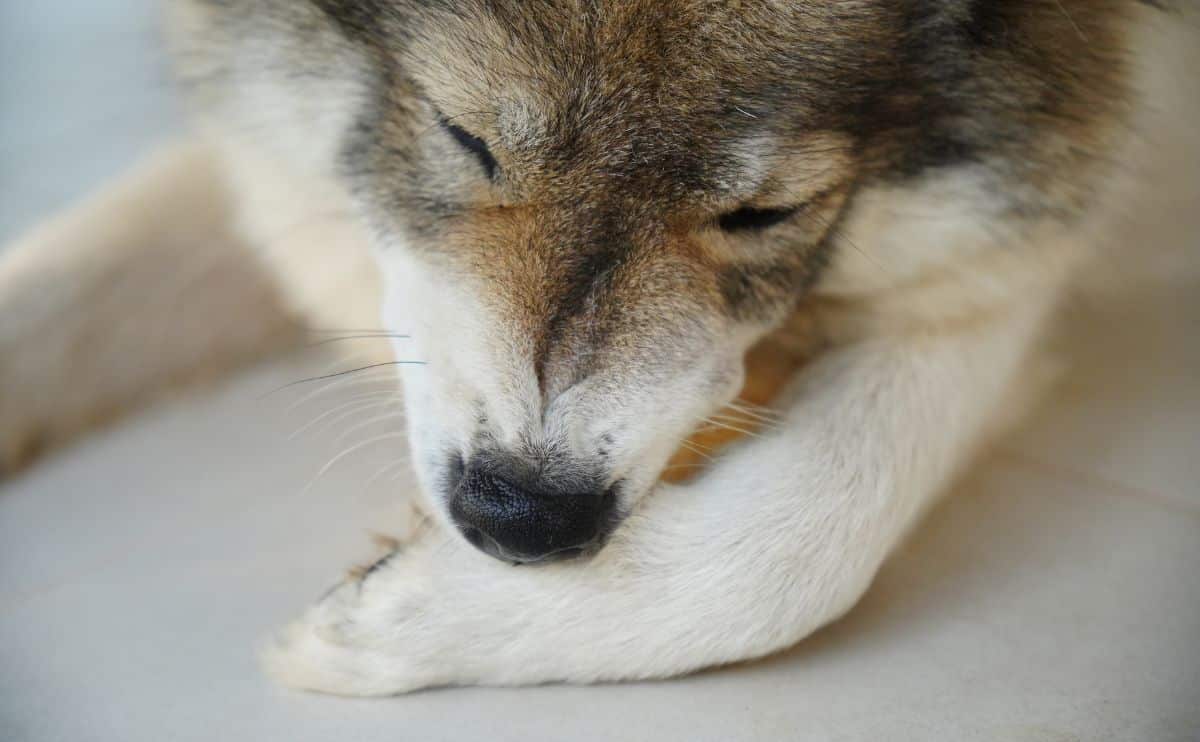Dog Lice Are More Common Than You Think – Here’s How To Spot & Stop Them
When you purchase through links on our site, we may earn a commission. Here’s how it works.
Notice your dog scratching more than usual? It might not be fleas. It could be lice. Yep, dog lice are a thing, and they’re more common than you might think. These tiny parasites love to hide in your dog’s fur, causing nonstop itching, skin irritation, and a whole lot of discomfort. The worst part? They’re easy to miss if you don’t know what to look for.
Table of Contents
As a pet owner, you want to catch issues early, and that’s exactly what this guide is here to help you do. I’ll walk you through what dog lice are, how to spot the signs, the dangers they pose, and what really works to get rid of them. Plus, you’ll learn how to keep lice from returning, because once is more than enough.
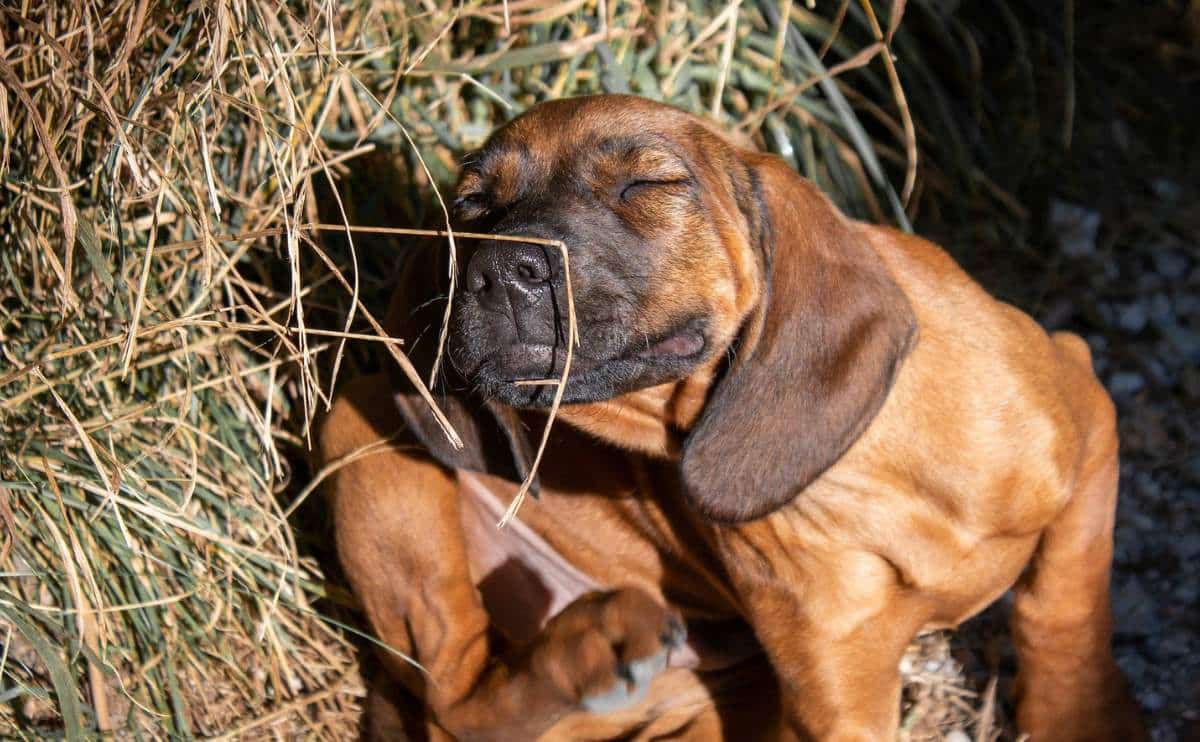
Can Dogs Really Get Lice?
Short answer? Yes, dogs can get lice. But don’t panic just yet.
Dog lice are a specific type of parasite that only affects dogs. They’re not the same kind of lice humans deal with, and thankfully, they don’t usually jump between species. So no, you’re not going to catch lice from your dog, and vice versa. Phew.
But here’s the deal: while lice on dogs aren’t as common as fleas, ticks, or other parasites, they still show up more than most pet parents realize. They tend to hang around in places where dogs are in close quarters, like shelters, dog parks, or grooming salons. But even your backyard explorer isn’t totally safe.
There are actually two main types of dog lice: chewing lice and sucking lice. One feeds on your dog’s skin debris, the other on blood. Either way? Neither are invited guests.
Veterinarians see lice cases pop up most often in dogs with compromised immune systems, poor grooming habits, or who haven’t been on consistent parasite prevention. They’re also more prevalent in cooler seasons. That’s why spotting the signs early and knowing how to treat and prevent lice is key to keeping your pup happy and healthy.
So, if your dog’s been scratching more than usual, don’t shrug it off. It could be the first clue that something more irritating (and itchy) is going on.
2 Types Of Lice That Affect Dogs
Are you wondering what the difference is between chewing lice vs. sucking lice? When it comes to lice on dogs, there are two main culprits, and yep, they both sound gross (because they are). But knowing which one your pup might be dealing with helps you treat the problem the right way.
1. Chewing Lice (Trichodectes canis)
These little pests are all about snacking on your dog’s skin flakes, hair, and oils. They don’t bite to suck blood, but they’re super irritating and can cause nonstop scratching. Chewing lice are more common in puppies, older dogs, or those that don’t get regular grooming. Bonus gross-out: they can even carry tapeworm eggs. Ew.
2. Sucking Lice (Linognathus setosus)
These guys are more aggressive. As the name suggests, sucking lice attach to your dog’s skin and feed on blood. This can lead to anemia, especially in smaller or already sick pups. If your dog seems weak or lethargic along with all the itching, sucking lice could be the reason.
Both types of lice are species-specific, meaning they only stick to dogs. So while you’re not at risk, your dog’s health (and sanity) absolutely is.
A vet can easily tell the difference under a microscope. This is why it’s always smart to get a professional opinion if you’re unsure. Knowing the exact type of lice helps target treatment fast and effectively.
Can Humans Give Lice To Dogs (Or Vice Versa)?
This is one of the first questions dog parents ask, and it makes total sense. If your kid came home with lice, or your dog’s been around others with skin issues, it’s only natural to wonder if those creepy crawlies can cross over. Here’s the good news: dog lice stick to dogs. Human lice stick to humans. They’re super picky about where they live, and they literally can’t survive on the wrong species.
Species-Specific Parasites
Dog lice are also different from the lice that infest cats and other pets. They’ve evolved to cling to canine fur and skin, and their little claws are designed just for dog hair shafts. Cats have their own species of chewing louse called Felicola subrostratus.
But Be Careful With Shared Spaces
Even though you’re safe, lice can still spread from dog to dog through shared bedding, grooming tools, collars, and close contact. Lice can’t fly, so direct contact with an infected dog is the only way to get them. If your pup’s been around other dogs and starts itching, it’s worth a closer look.
Lice infestations are more about cleanliness and exposure than anything else. So while you don’t have to panic about catching lice yourself, you do need to be proactive about checking your dog, cleaning their stuff, and calling your vet if you notice symptoms.
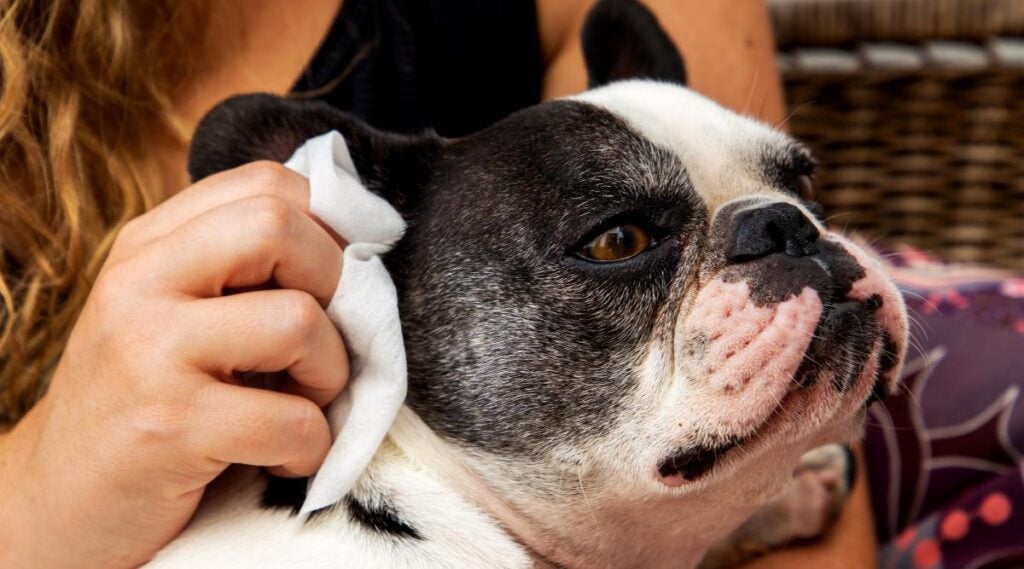
Understanding The Dog Lice Life Cycle
Ever wonder how those tiny pests manage to stick around? Understanding the life cycle of dog lice is key to kicking them out for good. Not just today, but long-term.
Lice don’t just show up one day and disappear the next. Once they find a host (your dog), they settle in fast and start multiplying. Like, really fast. Here’s how the life cycle of a louse works:
Stage 1: Eggs (aka Nits)
Lice lay eggs right on your dog’s hair shafts, which are called nits and look like tiny white or yellowish specks. They’re super sticky and tricky to remove, which is why just killing adult lice isn’t enough. Nits take about 1 week to hatch.
Stage 2: Nymphs
Once hatched, baby lice, called nymphs, start feeding and growing. They go through a few molts over 7–10 days until they become full-blown adults. During this time, they’re just as itchy and irritating as the grown-ups.
Stage 3: Adults
Adult lice live a total life span of 2 to 4 weeks. Females lay eggs their entire life to keep the cycle going. They are about the size of a sesame seed and live close to your dog’s skin. They feed on dead skin (chewing lice) or blood (sucking lice), and they start laying more eggs within a few days. The entire cycle repeats every 3 weeks if left untreated.
Why This Matters
Most treatments only kill adult lice, not the eggs. That’s why it’s crucial to treat your dog more than once and clean everything they’ve come into contact with. If you miss the eggs, you’re looking at a re-infestation in no time.
Veterinary Tip: Most vets recommend repeating treatment after 2 weeks to catch any newly hatched lice before they can mature and start the cycle all over again.
So, yes, when it comes to lice, knowing the life cycle isn’t just biology. It’s your game plan for winning the battle.
What Does Dog Lice Look Like?
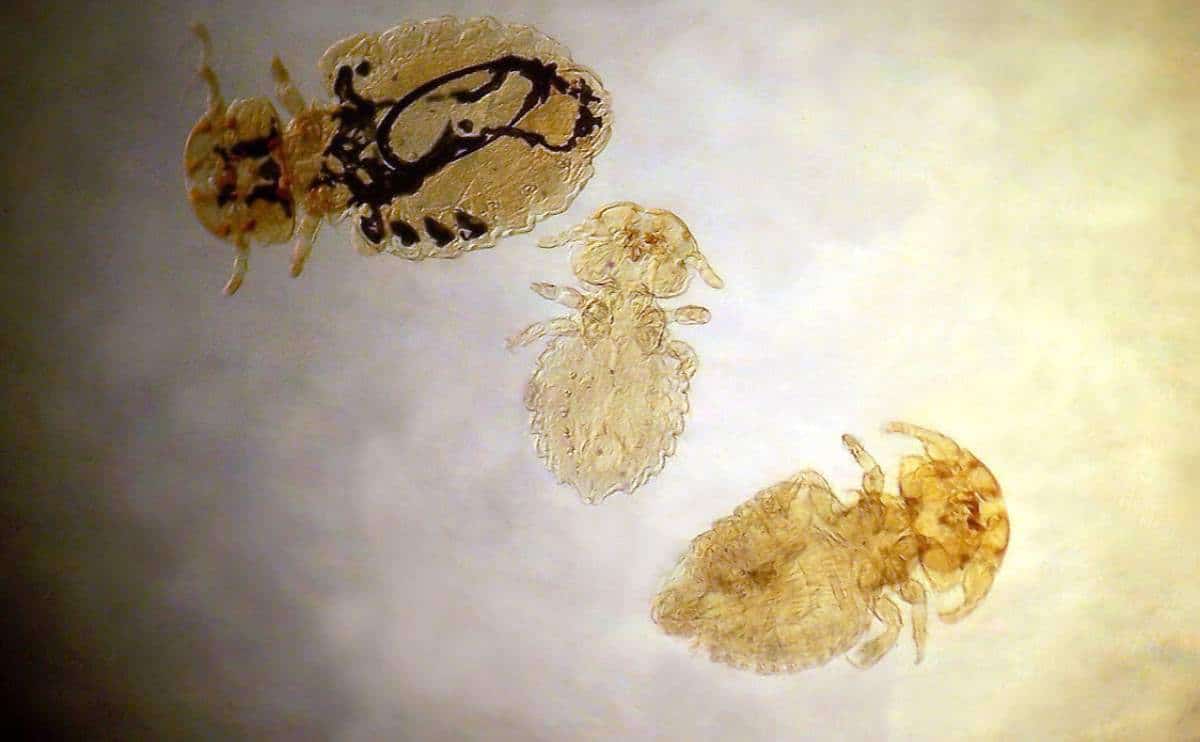
Dog lice are insects with flat bodies and six legs. Each leg has a claw-like hook that helps them adhere to the hair.
Adult lice are around 2 to 4 millimeters long, which is big enough to see with the naked eye. Nymphs are more challenging to see because they’re smaller than adults but look alike. Nits look a lot like dandruff: tiny white specks on the hair. However, nits stick to the hair, whereas dandruff shakes off easily.
Depending on the type, they can be:
- Chewing Lice – flat, wide, and yellowish-white
- Sucking Lice – narrower, darker, and slightly longer
If you’re concerned you won’t be able to tell if your dog has lice or fleas, rest assured, it’s easy to tell the difference. Lice are browner in color compared to black fleas, and lice move very slowly compared to scurrying fleas. Learn more in our article about flea collars and how to keep fleas at bay.
Dog Lice Symptoms: How To Spot The Signs Early
When it comes to lice, early detection makes all the difference. The sooner you catch the signs, the easier it is to treat, and the less your poor pup has to suffer.
But here’s the thing: dog lice symptoms can look a lot like other skin issues, like fleas, allergies, or even dry skin. That’s why it helps to know exactly what to watch for.
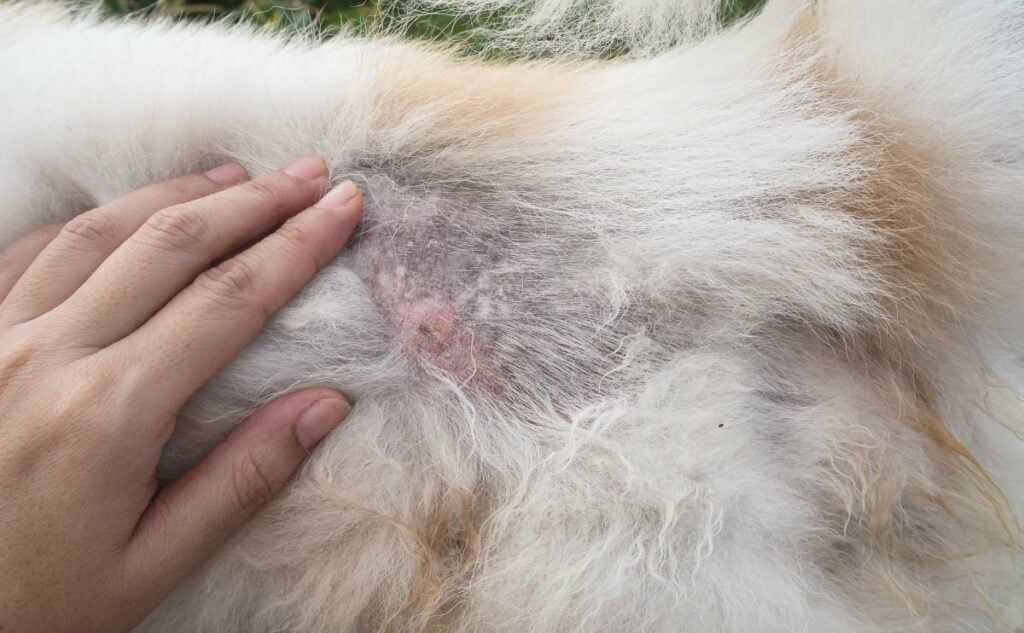
Common Signs Your Dog Might Have Lice
- Excessive Scratching or Biting at the Skin. Your dog may seem obsessed with certain areas, especially around the ears, neck, shoulders, or tail base.
- Dry, Flaky Skin or Redness. Lice irritate the skin, which can cause inflammation, dandruff-like flakes, or even small wounds from scratching.
- Hair Loss or Thinning Fur. If you notice bald patches or uneven fur, lice may be the culprits, especially if it’s paired with itching.
- Matted or Unkempt Fur. Lice and their eggs can cause fur to clump or tangle, especially in long-haired dogs. If your dog’s coat suddenly looks messy or hard to brush through, it’s worth a closer look.
- Tiny White or Tan Specks in the Fur. These could be nits (lice eggs) or the lice themselves. Use a flea comb to inspect the hair close to the skin.
- Scabs or Sores. Persistent scratching can lead to skin damage, skin infections, or scabbing, making your dog more uncomfortable.
- Restlessness or Irritability. If your usually chill pup seems agitated or uncomfortable, lice might be making life miserable.
Pro Tip: If you suspect lice, don’t delay. Book a vet visit. A quick exam (and maybe a microscope check) can confirm the diagnosis fast and get your dog started on the proper treatment.
In this 4-minute video from veterinarian Dr. Jones, he talks about how you can tell if your dog has lice.
So, if your dog’s scratching is out of the ordinary and nothing else seems to explain it, lice should absolutely be on your radar.
Treatment Guide: How To Get Rid Of Lice On Dogs
So, you’ve spotted the signs and confirmed it’s lice. Now what? Don’t worry, with the right approach, you can get rid of dog lice safely and effectively. It just takes a little persistence and some strategic steps. Althought it’s unlikely that your dog will get lice if you’re using a monthly flea and tick preventive treatment, it’s still possible.
Step 1: Kill The Lice Safely
Your first mission: eliminate the live lice crawling around in your dog’s fur. There are a few different ways to go about it:
- Medicated Shampoos. Look for shampoos specifically formulated for parasites like lice, with ingredients like pyrethrin or permethrin (but never use these on cats as they’re toxic!). Follow the label carefully and leave the lather on for the full recommended time.
- Topical Treatments or Spot-on Products. Some monthly flea and tick preventatives, like selamectin or fipronil, also kill lice. Your vet can recommend the best option based on your dog’s size, age, and health.
- Oral Medications. In more severe cases, your vet might prescribe something like ivermectin to tackle the infestation from the inside out.
To kill the lice, you may want to consider using an insecticide. Several products you can buy, like Vet’s Best Flea & Tick Home Spray and Advantage Spray, contain insecticides. Remember, insecticides will not kill the lice eggs.
If you’re looking for a home remedy for getting rid of lice, you can consider a homemade flea and tick preventative treatment. I’ll walk you through natural homemade preventatives next. It may help kill some of the lice and prevent them in the future. Again, check with your vet before you begin any treatment.
Important: Not all lice-killing products are safe for puppies, seniors, or dogs with health issues. Always check with your vet before starting treatment.
Step 2: Remove Nits & Eggs Thoroughly
Here’s where things get tedious, but necessary. Lice eggs (nits) are sticky and cling to hair shafts, so they won’t just rinse away.
- Use a fine-toothed flea comb to manually remove nits
- Comb slowly, section by section, especially around the ears, neck, and tail
- Repeat combing daily for at least 7–10 days to catch anything that hatches
For a mild case, you can use a special flea comb. This fine-tooth comb will remove the attached lice and eggs from your dog’s hair. Because you can’t kill the eggs with insecticides, the flea comb is the best way to remove them. You must use the flea comb regularly for a month or more to ensure complete lice eradication. If your dog is infested with lice, shaving your dog is an excellent way to remove lice and eggs. But only do this if your vet suggests to.
Pro Tip: Dipping your comb in hot water or diluted white vinegar between strokes can help loosen stubborn nits.
Step 3: Clean Your Dog’s Environment
Even though lice don’t survive long off a host, it’s still crucial to clean anything your dog has come into contact with to avoid reinfestation.
- Machine wash as much as you can
- Wash bedding, blankets, and toys in hot water and high heat (but always read the product’s cleaning instructions)
- Disinfect brushes, collars, and grooming tools
- Vacuum carpets, furniture, and car interiors thoroughly
If you have other dogs at home, treat them too, even if they’re not showing symptoms yet. Left untreated, lice can cause an infestation, which can cause more severe health issues like anemia or additional parasites. See our guide on the best pet-safe cleaning products for more helpful cleaning tips.
Stick with it: Most lice infestations clear up in 2–3 weeks with consistent treatment. But missing just one step, or skipping the follow-up dose, could mean starting over.
Natural vs. Chemical Treatments For Dog Lice: What Works Best?
When it comes to treating lice on your dog, one of the biggest decisions you’ll face is this: Do you go the natural route, or stick with vet-approved chemicals?
Spoiler: both can work. But there are pros, cons, and safety notes you absolutely need to know before picking a path.
Natural Treatments For Dog Lice
Many pet parents want to avoid harsh chemicals, especially for puppies, seniors, or sensitive-skinned pups. While natural methods may not be as fast-acting, they can be helpful when used consistently and carefully. Popular natural options:
- Neem Oil. Has antiparasitic properties; can be diluted and used in baths or sprays
- Apple Cider Vinegar. Believed to loosen lice eggs when mixed with water and applied topically
- Coconut Oil. May smother lice and soothe irritated skin
- Essential Oils. Options like lavender or eucalyptus can be used in homemade sprays (but many essential oils are toxic if misused, so please consult your vet first!)
Pros: Gentle on skin, less risk of side effects
Cons: May take longer to work, less effective for severe infestations
Important: Always check with your vet before using oils or natural remedies. Some ingredients can be toxic to dogs if ingested or absorbed through the skin.
Chemical Treatments For Dog Lice
Veterinary-approved chemical treatments are faster, clinically tested, and often more reliable, especially for moderate to severe infestations. Common options include some of the options mentioned above.
Pros: Fast-acting, vet-approved, kills lice and eggs with repeated use
Cons: Possible skin sensitivity or side effects in some dogs
These treatments are often used in combination with environmental cleaning and follow-up doses to completely break the lice life cycle. With your vet’s go-ahead, you can also use both a combination of natural and chemical, depending on the severity of your dog’s lice infestation.
So, Which One’s Best?
- For mild cases or preventative care, natural remedies may help, with your vet’s blessing.
- For confirmed infestations, especially with nits and skin irritation, chemical treatments are usually more effective and efficient.
Ultimately, the best option is the one that’s safe, effective, and tailored to your dog’s specific needs. Talk to your vet about what makes sense based on your dog’s age, size, health history, and severity of infestation.

When To See A Vet & What To Expect
Some pet parents hesitate to call the vet when they suspect lice. “Is this serious enough?” “Can I just treat it at home?” Totally fair questions, but when it comes to parasites like lice, it’s always better to be safe (and itch-free) than sorry.
Here’s when to stop guessing and get a professional diagnosis:
- You’ve spotted lice, nits, or weird specks in your dog’s fur
- Your dog is scratching constantly or seems uncomfortable
- There’s hair loss, scabbing, or signs of infection
- Home treatments aren’t working, or symptoms keep coming back
- You’re not sure if it’s lice, fleas, mites, or something else
Even if it’s not lice, these symptoms signal that something’s up. Your vet can quickly rule things out and recommend the right course of action.
What The Vet Will Do
The good news is that diagnosing lice is usually quick and simple. Here’s what you can expect at the vets:
- A physical exam focused on the skin and coat
- A flea comb inspection to look for live lice or eggs
- Possibly a microscope check to confirm the diagnosis
- A discussion of treatment options tailored to your dog’s size, age, and health
- Recommendations for cleaning, follow-up, and prevention
In some cases, if your dog has scratched themselves raw or shows signs of a secondary infection, the vet may also prescribe antibiotics or medicated creams to help the skin heal.
Don’t Worry, Vets See This All The Time
Lice might feel icky, but it’s nothing to be embarrassed about. Dogs get lice. Vets treat lice. It’s just part of life with pets. The most important thing? Taking action quickly. That’s how you break the life cycle, stop the scratching, and keep your pup comfy.
How Can Dog Lice Be Prevented?
Owners cannot guarantee their pets will not be exposed to lice, but there are some preventative measures to take.
- Monthly antiparasitic flea and tick prevention
- Clean grooming tools after each use
- Regular cleaning and disinfection of bedding
- Prevent contact with lice-infested pets or animals
- Proper diet and health care to keep dogs in good health
- Sanitary living conditions to prevent lice
Are Certain Dog Breeds More At Risk For Lice?
If your pup has ever dealt with lice, you’ve probably wondered: Is it something about their breed? Coat type? Size? While lice don’t exactly play favorites, some dogs are more prone to infestations than others, and it’s not just about breed.
Coat Type Plays A Big Role
Lice love a thick, dense coat. It gives them plenty of places to hide, lay eggs, and avoid detection. That means dogs with long or double-layered fur may be more susceptible, simply because lice are harder to spot and remove.
Higher-risk coat types include:
- Long-haired breeds (e.g., Shih Tzus, Afghan Hounds, Collies)
- Double-coated dogs (e.g., Huskies, German Shepherds)
- Fluffy or curly-coated pups (e.g., Poodles, Bichons)
Matting or poor grooming makes it even easier for lice to go unnoticed, which is why regular brushing matters!
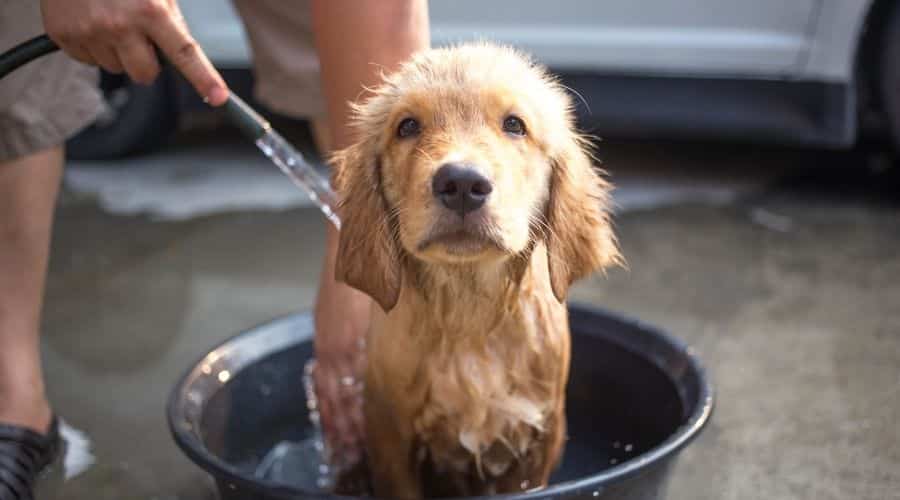
Health & Hygiene Matter More Than Breed
More than genetics, a dog’s health and hygiene routine are the biggest factors in lice risk. Dogs are more likely to get lice if they:
- Are immunocompromised or recovering from illness
- Live in crowded conditions (shelters, kennels, rescue facilities)
- Aren’t on a regular flea/tick/lice prevention plan
- Have poor grooming or rarely get bathed
Rescue dogs, senior dogs, and puppies tend to be more vulnerable, simply because their immune systems or grooming routines aren’t as robust.
Which Breeds Might Be Less Susceptible?
Short-haired breeds like Beagles, Greyhounds, or French Bulldogs may have a lower risk, only because lice are easier to spot and remove quickly. But again, no dog is immune.
Bottom line: No breed is completely safe from lice, but with good hygiene and a sharp eye, you can keep the risk low. No matter what kind of coat your pup rocks.
Frequently Asked Questions About Dog Lice
Still scratching your head about a few things? Here are some of the most common questions dog parents ask about lice. If you don’t see your question below, please ask us in the comments, and we’ll find the answer for you.
Can Dogs Get Lice From Humans?
Nope. Lice are species-specific. Human lice only infest humans, and dog lice only infest dogs. So, while you can’t give your dog lice (or catch it from them), they can catch it from other dogs.
What Do Lice Look Like On A Dog?
Dog lice are tiny, flat insects, typically about the size of a sesame seed. They’re white or tan and crawl slowly. You might also see nits (eggs) attached to your dog’s hair shafts, especially around the ears, neck, or tail base.
How Do I Know If My Dog Has Lice Or Fleas?
Fleas move fast and jump. Lice crawl slowly and cling to the fur. Fleas leave behind black “flea dirt” (droppings), while lice leave visible eggs stuck to hair. A vet or magnifying glass can help confirm which is which.
Can Dog Lice Live On Furniture?
Not for long. Dog lice can survive about 1–2 days off a host. This is why it’s important to clean bedding, brushes, and furniture after treatment. Thankfully, they won’t infest your home like fleas or mites.
Are Some Dog Breeds More Prone To Lice?
Lice can affect any breed, but long-haired, double-coated dogs (like Collies, Huskies, and Shih Tzus) are more prone simply because lice are harder to spot and remove. Dogs with weaker immune systems are also at higher risk.
How Long Does It Take To Get Rid Of Lice On Dogs?
With proper treatment and follow-up, most lice infestations clear up in 2–3 weeks. The key is consistency, repeating treatments, removing eggs, and cleaning your dog’s environment thoroughly.
Can Lice Make My Dog Sick?
Sometimes. In severe cases, especially with sucking lice, lice can cause anemia, skin infections, or extreme discomfort. That’s why early treatment is so important.
What Else Could Be Bothering Your Dog’s Skin?
Dog lice can be an uncomfortable and challenging experience for you and your dog. But they are not the only thing that can irritate your dog’s skin. Read our articles on common dog skin allergies and typical dog skin conditions so you can learn how to recognize the symptoms and treat your dog quickly and safely. Some dogs simply have sensitive skin. If your dog’s skin is overly sensitive, you may need to discuss a special dog food for allergies with their vet.
Have you ever dealt with lice on your dog? Share your story or dog lice tips in the comments below, as your experience might help another pet parent. We’d love to hear from you!
Why Trust Canine Journal
Julie is a writer and researcher for Canine Journal and the team’s go-to dental expert. With over 15 years of experience in the dental field and a lifelong love for dogs, she brings a detail-oriented, health-focused perspective to every piece she writes. While her passion began with canine dental care, she’s now deeply invested in helping pet parents navigate all kinds of health concerns, including unexpected issues like lice infestations. Julie also enjoys writing breed-specific guides and researching products that make life better (and itch-free) for pups everywhere. Growing up with Brittany Spaniels, she now happily spoils every dog in her life with love, snuggles, and the occasional deep-dive on parasite prevention.
